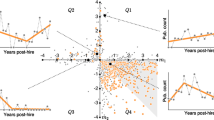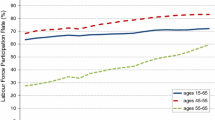Abstract
Many organizations—faculties, firms, political bodies, societies, national academies—have recently been faced with the problem of aging. These trends are caused by increasing longevity of the members of these organizations as well as a lower intake at younger ages. The aging problem is particularly pronounced in organizations of fixed size, where no dismissal due to age (up to a statutory “retirement” age) is acceptable. Attenuating the aging process in a fixed-size organization by recruiting more young people leads to another adverse effect: the number of recruitments will decline, so the chances to be recruited decrease. For multi-level organizations transition flows between the levels and recruitment at different levels complicate the aforementioned problems. In this paper we present a methodology that can help design election policies based on different objective functions related to the age structure and size of two-level organizations, without compromising too much the already established election criteria. Technically, this methodology is based on multi-objective optimization making use of optimal control theory. The current election policies for both full and corresponding members of the Austrian Academy of Sciences constitute the benchmark with which we compare our results based on alternative objective functions.
Similar content being viewed by others
References
Arnold VI (1992) Ordinary differential equations, 3rd edn. Springer, Berlin
Arthur WB, McNicoll G (1977) Optimal time paths with age-dependence: a theory of population policy. Rev Econ Stud 44: 111–123
Bartholomew DJ (1982) Stochastic models for social processes, 3rd edn. Wiley, London
Chung SK, Park SJ (1996) Optimal control of promotion and recruitment in a hierarchically graded manpower system. IMA J Manag Math 7(3): 197–206
Cohen JE (2003) How many members could the National Academy of Sciences have? Mimeo. Rockefeller University and Columbia University, New York
Cohen JE (2009) The demography of the resident membership of the American philosophical society. In: Proceeding of the American Philosophical Society, vol 153, no. 2. Philadelphia, USA
Dawid H, Feichtinger G, Goldstein JR, Veliov VM (2009) Keeping a learned society young. Demogr Res 20: 541–558
Feichtinger G, Mehlmann A (1976) The recruitment trajectory corresponding to particular stock sequences in Markovian person-flow models. Math Oper Res 1: 175–184
Feichtinger G, Steinmann G (1992) Immigration into a population with fertility below replacement level—the case of Germany. Popul Stud 46: 275–284
Feichtinger G, Tragler G, Veliov VM (2003) Optimality conditions for age-structured control systems. J Math Anal Appl 288: 47–68
Feichtinger G, Prskawetz A, Veliov VM (2004) Age-structured optimal control in population economics. Theor Popul Biol 65: 373–387
Feichtinger G, Winkler-Dworak M, Freund I, Prskawetz A (2007) Age dynamics and optimal recruitment policies of constant sized organizations. An application to the Austrian Academy of Sciences. In: Lutz W (eds) Vienna yearbook of population research. Austrian Academy of Sciences, Vienna, pp 107–131
Feichtinger G, Veliov VM (2007) On a distributed control problem arising in dynamic optimization of a fixed-size population. SIAM J Optim 18(3): 980–1003
Grass D, Caulkins JP, Feichtinger G, Tragler G, Behrens DA (2008) Optimal control of nonlinear processes with applications in drugs, corruption, and terror. Springer, Berlin
Henry L (1975) Perspectives d’evolution d’un corps. Popul 30: 241–270
Keyfitz N (1977) Applied mathematical demography. Wiley, New York
Keyfitz BL, Keyfitz N (1997) The McKendrick partial differential equation and its uses in epidemiology and population study. Math Comput Model 26(6): 1–9
Leridon H (2004) The demography of a learned society. The Académie des Sciences (Institut de France). Popul 59(1): 81–114
Mitra S (1990) Immigration, below-replacement fertility, and long-term national population trends. Demography 27: 121–129
Pontryagin LS, Boltyanskii VG, Gamkrelidze RV, Mischenko EF (1962) The mathematical theory of optimal processes. Interscience, New York
Prskawetz A, Veliov V (2007) Age specific dynamic labor demand and human capital investment. J Econ Dyn Control 31: 3741–3777
Schmertmann CP (1992) Immigrants’ ages and the structure of stationary populations with below replacement fertility. Demography 29(3): 595–612
Van de Kaa DJ, de Roo Y (2007) The members of the Royal Netherlands Academy of Arts and Sciences: 1808 to 2000. A demographic view. NIDI Working Paper, The Hague, NIDI
Vaupel JW (1981) Over-tenured universities: the mathematics of reduction. Manag Sci 27(8): 904–913
Winkler-Dworak M (2008) The low mortality of a learned society. Eur J Popul 24(4): 405–424
Wu Z, Li N (2003) Immigration and the dependency ratio of a host population. Math Popul Stud 10: 21–39
Yang WY, Cao W, Chung T-S, Morris J (2005) Applied numerical methods using MATLAB. Wiley, New York
Author information
Authors and Affiliations
Corresponding author
Rights and permissions
About this article
Cite this article
Feichtinger, G., Krasovskii, A.A., Prskawetz, A. et al. Optimal age-specific election policies in two-level organizations with fixed size. Cent Eur J Oper Res 20, 649–677 (2012). https://doi.org/10.1007/s10100-011-0197-4
Published:
Issue Date:
DOI: https://doi.org/10.1007/s10100-011-0197-4




